Tribeca’s Newest Park
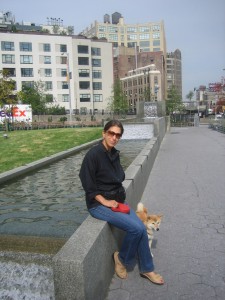
“The space does have its challenges,” says artist Elyn Zimmerman (right) as we meet at one of the chess tables in the new CaVaLa Park. Chief among those challenges is the location: CaVaLa is an abbreviation of the three streets—Canal, Varick, and Laight—that border it. And yet, CaVaLa Park is proof that there’s truth in the maxim, “If you build it, they will come.” In the half hour we spend there, young boys dip their hands in the fountain, workers stroll through, and tourists snap photos.
The park is the latest incarnation of a piece of land that has changed much over the centuries. “In 1767, the area was swampland,” according to the Lower Manhattan Construction Command Center website, LowerManhattan.info. “In the late 1800’s, Canal Street served as an actual canal and the triangle was a part of it. By 1921, the canal was paved over and the Crucible Steel Company occupied the triangular shaped parcel. Later that decade, the Crucible building was demolished to make way for the elevated subway line. Finally, in the 1940’s, the triangle was morphed into a cobbled roadbed and served as a parking lot until recently. In 2005, the New York City Department of Parks and Recreation proposed building a park on the parcel of land and was given ownership of the area by the Department of Transportation. Later that year, DOT constructed sidewalks around the triangle to complement the park that was yet to be built. In 2006, the Tribeca Film Festival donated money to the Department of Parks and Recreation to recreate the triangle into a grassy lawn for patrons.”
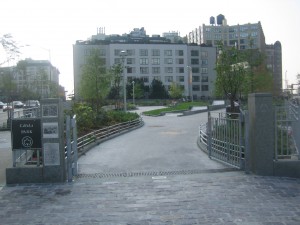
 The park was designed by Zimmerman, who has lived in Tribeca for more than 30 years (“since before the Odeon!”), and Gail Wittwer-Laird, a landscape designer with the Parks Department. Their goal was as much lightness as possible—no black benches or black fences, and fencing and gates that were the minimum-required height. “Do you see that black fencing across the street? This park would have a very different feel if it were surrounded by black fences.” The designers also paid homage to the area’s history with old maps and images on metal plates inserted into the pillars at the park’s three entrances.
The park was designed by Zimmerman, who has lived in Tribeca for more than 30 years (“since before the Odeon!”), and Gail Wittwer-Laird, a landscape designer with the Parks Department. Their goal was as much lightness as possible—no black benches or black fences, and fencing and gates that were the minimum-required height. “Do you see that black fencing across the street? This park would have a very different feel if it were surrounded by black fences.” The designers also paid homage to the area’s history with old maps and images on metal plates inserted into the pillars at the park’s three entrances.
When I observe that the park already seems like it’s been here for years, Zimmerman is pleased. “‘Inevitable’ is the highest compliment,” she says.
Every design process has its obstacles, and in this case, there was a lot going on underground—sewers, electricial wiring, even archaelogical artifacts—that had to be dealt with. (Construction was halted whenever something was discovered, so the city’s archaeologists could come inspect it. Several times they thought they had discovered remnants of the canal, only to determine that they hadn’t.) Beneath the main part of the fountain is what Zimmerman describes as “basically a room,” and the Hudson River is close enough that flooding was an issue.
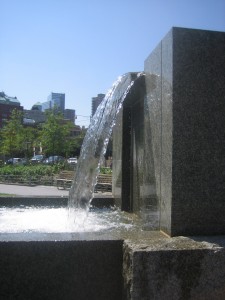
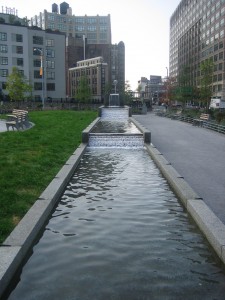 The granite fountain is the park’s figurative centerpiece. “The Parks Department wanted water, and I felt strongly it should reference Canal Street,” says Zimmerman, who titled the piece Canal Waterworks. The idea was to keep it low and unobtrusive, and it’ll even be more so when the landscaping grows in. Although there’s a pump under the base of the waterfall, the rest of the fountain works by gravity—the soothing sound of the water provides relief from the inevitable traffic noise. The fountain is also named the Paul Milstein Fountain, in honor of the real-estate developer and philanthropist whose Paul and Irma Milstein Foundation helped fund the park’s construction, along with the Lower Manhattan Development Corporation and the mayor’s office.
The granite fountain is the park’s figurative centerpiece. “The Parks Department wanted water, and I felt strongly it should reference Canal Street,” says Zimmerman, who titled the piece Canal Waterworks. The idea was to keep it low and unobtrusive, and it’ll even be more so when the landscaping grows in. Although there’s a pump under the base of the waterfall, the rest of the fountain works by gravity—the soothing sound of the water provides relief from the inevitable traffic noise. The fountain is also named the Paul Milstein Fountain, in honor of the real-estate developer and philanthropist whose Paul and Irma Milstein Foundation helped fund the park’s construction, along with the Lower Manhattan Development Corporation and the mayor’s office.
When I remark how the six-year-old me would’ve spent hours floating leaves and twigs down the fountain’s length, Zimmerman says that one of the joys of creating public works is seeing how people interact with them. “If it doesn’t harm people or the sculpture, I’m fine with it.” The metal plates inserted along the curbs and the fountain were required by the Parks Department to discourage skateboarders; the braces beneath skateboards are murder on stone.
As we leave, Zimmerman points out one of her favorite things about the park: “I love how you have a great view of the Empire State Building.” —Erik Torkells















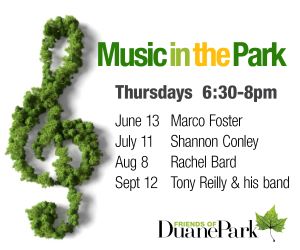
Nice piece and a beautiful park. I once had an old print of the canal on Canal St. I’m reminded by the new canal. Congrats to all on bringing water and green to what was a fairly desolate area.
Its amazing how the sounds of nature can neutralize the noxious sounds of the city. A moments peace can last a whole day.
Its amazing how the sounds of nature can neutralize the noxious sounds of the city and a moments peace can last a whole day. Really nice job by Ms Zimmerman.
When Isamu Noguchi finished working on a park it was always fun to imagine how his organic pieces just grew into place…..seemingly overnight. Elyn Zimmerman’s latest contribution to the esthetic character of New York has a similar effect. What a cool compliment to the recently opened Highline Park a dozen or so blocks north.